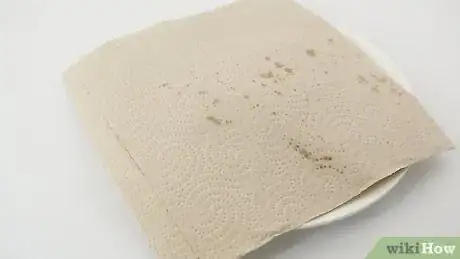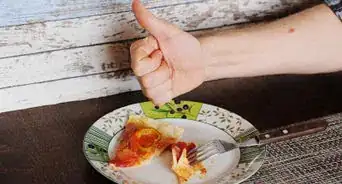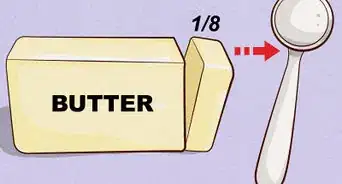This article was co-authored by wikiHow staff writer, Amy Bobinger. Amy Bobinger has been a writer and editor at wikiHow since 2017. She especially enjoys writing articles that help people overcome interpersonal hurdles but frequently covers a variety of subjects, including health and wellness, spirituality, gardening, and more. Amy graduated with a B.A. in English Lit from Mississippi College in 2011 and now lives in her hometown with her husband and two young sons.
There are 8 references cited in this article, which can be found at the bottom of the page.
This article has been viewed 654,996 times.
Learn more...
Pizza is delicious any time of the day or night, and cold pizza is perfectly fine every once in a while, but reheating leftover pizza can leave you with a soggy, rubbery, or dried out mess. Whether you made the pizza yourself or ordered a late-night delivery, by storing the pizza properly and taking the time to reheat it with care, you can enjoy a slice that’s nearly as good as it was when it was fresh!
Steps
Storing the Pizza
-
1Line a plate or an airtight container with paper towels. If you take a little time when you’re putting the pizza away, you’ll end up with fresher-tasting leftovers, and the texture will be much more similar to the way it was originally. Start by putting a layer of paper towels or parchment paper on the bottom of a plate or a container that’s big enough to hold 1 or 2 slices of your pizza.[1]
- While it can be tempting to throw the whole box of pizza straight into the refrigerator, it can make your pizza soggy. The moisture from the tomato sauce, veggies, and meat will soak into the crust, making it hard to get the perfect texture no matter how you reheat the pizza.
- If you know in advance you’re planning to freeze the pizza, it’s better to use an airtight container, rather than a plate.
In a Hurry? Let the pizza cool to room temperature, then place the slices in a resealable plastic bag. They might dry out a little more than they would if you layered them with paper towels, but they'll still stay fresher than putting the whole box in the fridge.
-
2Stack the pizza on the plate with more paper towels between each layer. Place your pizza in a single layer on top of the plate, then add another layer of paper towels. If you have more pizza than you can fit in a single layer, continue alternating pizza and paper towels until you’ve stacked all of the slices.[2]
- If you need to, divide the pizza onto more than 1 plate or container.
Advertisement -
3Cover the plate in plastic wrap or put the lid on the container. Once you’ve stacked everything together, wrap plastic film around the entire plate or container. This will help keep the pizza fresh by sealing out as much air as possible.
- If you’re using a container with an airtight lid, you can just close the container, instead.
-
4Place the pizza in the fridge if you plan to eat it within 3-5 days. Keeping the pizza in the refrigerator will keep it from spoiling for up to 5 days, and it won’t alter the texture of the pizza as much as freezing will. However, it won’t last there indefinitely, so you should only keep the pizza in the fridge if you plan to eat or freeze it within a few days.[3]
- If you haven’t eaten the pizza by the 3rd day, throw it out or freeze it.
-
5Store your pizza in the freezer to keep it fresh for up to 6 months. Freezing pizza will preserve it for about 6 months, so it’s a great option if you have a lot of extra pizza on hand and you know you won’t eat it within a few days.[4]
- If you stored your pizza on a plate to start with, transfer it to an airtight container instead. However, do keep the paper towels between the slices.
- Defrost your pizza for about an hour on the counter before you re-heat it for the best results.
Tip: If you buy a frozen pizza, it will often last in your freezer for about a year. However, these pizzas are flash-frozen commercially and designed to have a longer shelf life. To be safe, consume pizza you freeze yourself within 6 months.
Reheating Leftover Pizza
-
1Heat the pizza in the oven to get a crispy crust. Preheat your oven to 350 °F (177 °C) for 5-10 minutes, allowing it to come all the way up to temperature. When it’s ready, place your pizza on a baking sheet, then place it in the oven for about 5 minutes. Whether you’re heating up a whole pizza or just a slice, the oven is a great way to get a crispy crust with bubbly cheese that’s similar to your original pizza.[5]
- If you have a pizza stone, place the pizza on that. It will distribute the heat evenly, resulting in an even crispier crust.
- For easy cleanup, line your baking sheet with parchment paper before you place the pizza on it.
Tip: If any of the toppings look soggy, wilted, or dried out, pick them off before you reheat the pizza.
-
2Use your toaster oven for a quick way to heat up 1-2 slices. Preheat your toaster oven to 400 °F (204 °C), then place the pizza inside. Leave it for about 10 minutes, or until the top looks bubbly and toasty.[6]
- Since toaster ovens are small, this technique is best if you’re only heating up enough pizza for 1 person.
-
3Try heating your pizza in a skillet for the best texture. Heat a cast iron skillet or a frying pan over medium heat. Once it’s hot, place 1 or 2 slices of pizza into the skillet and cover it with a lid. Let the pizza heat for 6-8 minutes without removing the lid. When it’s ready, you’ll have a nice, bubbly top, warm toppings, and a beautifully crispy crust.[7]
- Covering the pan allows the toppings to heat evenly while the crust is crisping on the bottom. If your skillet doesn’t have a lid, cover it with foil, instead.
- After 6-8 minutes, if your crust is still soggy but the toppings are warm, take the lid off of the skillet and let it continue to heat for a few more minutes.
-
4Reheat the pizza in the microwave for the fastest approach. Microwaving a pizza will change the texture, making the crust chewy and tough, so it’s not the preferred method of pizza connoisseurs. However, if you’re in a hurry, sometimes it’s the only way to go. To get the best possible texture out of the microwave, put a paper towel between the plate and the pizza, turn your microwave to 50% power, and nuke your pizza for about 1 minute.[8]
Tip: To keep the crust from getting soggy when you microwave it, try adding a glass of water. Place a microwave-safe glass that’s about half-full of water into the microwave along with your pizza. The water will absorb some of the microwaves that are bouncing around, which will cause the pizza will heat more evenly.[9]
Community Q&A
Did you know you can get answers researched by wikiHow Staff?
Unlock staff-researched answers by supporting wikiHow
-
QuestionShould pizza be kept in the fridge?
 wikiHow Staff EditorThis answer was written by one of our trained team of researchers who validated it for accuracy and comprehensiveness.
wikiHow Staff EditorThis answer was written by one of our trained team of researchers who validated it for accuracy and comprehensiveness.
Staff Answer wikiHow Staff EditorStaff AnswerPizza can spoil if you leave it out for too long, just like any other perishable food. Food safety experts say you’re relatively unlikely to get sick from eating a plain cheese or pepperoni pizza that’s been sitting out for hours or even a day. However, it’s more likely to be a problem if there are juicy toppings, like tomatoes or buffalo chicken. Plus, your pizza is more likely to dry out and get stale if you don’t refrigerate it.
wikiHow Staff EditorStaff AnswerPizza can spoil if you leave it out for too long, just like any other perishable food. Food safety experts say you’re relatively unlikely to get sick from eating a plain cheese or pepperoni pizza that’s been sitting out for hours or even a day. However, it’s more likely to be a problem if there are juicy toppings, like tomatoes or buffalo chicken. Plus, your pizza is more likely to dry out and get stale if you don’t refrigerate it. -
QuestionHow do you keep pizza from drying out?
 wikiHow Staff EditorThis answer was written by one of our trained team of researchers who validated it for accuracy and comprehensiveness.
wikiHow Staff EditorThis answer was written by one of our trained team of researchers who validated it for accuracy and comprehensiveness.
Staff Answer wikiHow Staff EditorStaff Answer
wikiHow Staff EditorStaff Answer -
QuestionCan you store pizza in the oven?
 wikiHow Staff EditorThis answer was written by one of our trained team of researchers who validated it for accuracy and comprehensiveness.
wikiHow Staff EditorThis answer was written by one of our trained team of researchers who validated it for accuracy and comprehensiveness.
Staff Answer wikiHow Staff EditorStaff Answer
wikiHow Staff EditorStaff Answer
Warnings
- Don't put a pizza box in the oven. Not only will it make your pizza taste like cardboard, but it can be a fire hazard. In addition, heating the cardboard and dye could release harmful chemicals into your food and your home.[10]⧼thumbs_response⧽
References
- ↑ https://www.thekitchn.com/the-best-ways-to-store-leftover-pizza-220955
- ↑ https://www.thekitchn.com/the-best-ways-to-store-leftover-pizza-220955/
- ↑ http://www.eatbydate.com/grains/pizza-shelf-life-expiration-date/
- ↑ http://www.eatbydate.com/grains/pizza-shelf-life-expiration-date/
- ↑ https://www.tasteofhome.com/article/how-to-reheat-pizza/
- ↑ https://www.goodhousekeeping.com/food-recipes/cooking/tips/a20707/reheating-pizza/
- ↑ https://www.tasteofhome.com/article/how-to-reheat-pizza/
- ↑ https://bestlifeonline.com/best-way-to-reheat-pizza/
- ↑ https://sciencenotes.org/why-microwave-pizza-with-a-glass-of-water/
About This Article
To store and reheat pizza, start by lining an airtight container with paper towels. Then, put the pizza in the container and cover it with another layer of paper towels, which will help absorb moisture so the pizza lasts longer. Store the pizza in the fridge until you're ready to eat it. When you want to reheat the pizza, put it on a baking sheet and cook it in the oven at 400 °F (205°C) for 6-10 minutes, depending on the thickness. Serve and enjoy!




















































